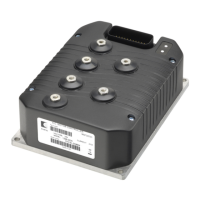Curtis 1298 Manual, os 11
1 1 J U LY 2 0 0 8 D R A F T
APPENDIX A
THEORY OF OPERATION
Curtis 1298 controllers convert DC battery power to 3-phase AC power by
precisely controlling the induction drive for high bandwidth, high efficiency,
and low ripple torque generation. To realize this level of precise torque control of
induction motor drives in electric vehicles, Curtis engineers carefully evaluated
and incorporated the latest technology in microprocessors, power electronics,
and motor control.
Invented by Nikola Tesla in 1888, the induction motor became a workhorse
that contributed to the vast industrial growth in the twentieth century. Until
recently relegated to non-dynamic applications where transient response wasn’t a
critical concern, induction motors are now a common motor of choice in high
performance control applications. This shift was facilitated by the enormous
advancements in microprocessors and power silicon devices in the last thirty
years, coupled with intense research and development.
The 3-phase induction motor has three sets of distributed windings in the
stator winding slots. The standard induction motor has a rotor with aluminum
bars short-circuited by cast aluminum end-rings. There are no brushes, com
-
mutators, or slip-rings, and—unlike DC and synchronous motors—there is
no need for permanent magnets or a separate current supply for the rotor. The
brushless construction of the induction motor and the rugged rotor provide
high reliability, fault tolerance, low maintenance, and low cost.
Three-phase sinusoidal voltages, electrically displaced by 120°, are applied
to the phase windings to create the stator magnetic field. The field rotates at
the stator voltage frequency divided by the number of pole pairs. This rotating
stator field induces currents in the conductive rotor bars by transformer action
which, in turn, create a second rotor magnetic field. The rotor field reacts to
the stator field to generate torque. The differential speed, or slip frequency,
between the stator field and rotor speed is critical to the torque and speed
control of an induction motor.
Motor Control Algorithms
Two main approaches are commonly used for induction motor control: scalar
control and vector control.
Scalar control (e.g., volts/Hz) modulates only the magnitude and frequency
of the applied voltage or current. Although scalar control has the advantage
of being simpler than vector control, it has poor dynamic response and lower
operation efficiency. The various methods used to improve performance require
extensive characterization of the motor and loads.
Vector control (e.g., indirect rotor flux orientation, stator flux orientation,
etc.) manipulates the magnitude, frequency, and phase of the control variables
APPENDIX A: THEORY OF OPERATION
A-1

